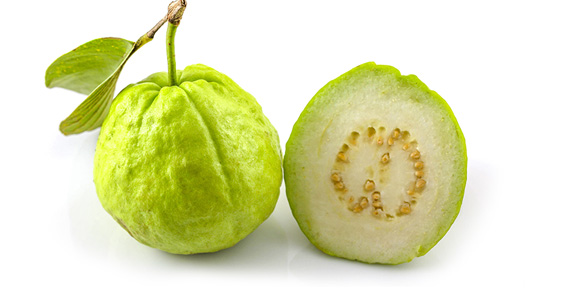
 Guava is a very popular fruit. It is available throughout the year except during the summer season. Being very hardy, it gives an assured crop even with
very little care. Its cost of production is also low because its requirements for fertilizer, irrigation and plant protection are not much. Further its nutritive value is very high. Therefore, it is and ideal fruit for the nutritional security. Guava is also grown as a backyard fruit to great extent.
In India, the best quality guavas are produced in Uttar Pradesh, particularly in Allahabad region.
Guava is a very popular fruit. It is available throughout the year except during the summer season. Being very hardy, it gives an assured crop even with
very little care. Its cost of production is also low because its requirements for fertilizer, irrigation and plant protection are not much. Further its nutritive value is very high. Therefore, it is and ideal fruit for the nutritional security. Guava is also grown as a backyard fruit to great extent.
In India, the best quality guavas are produced in Uttar Pradesh, particularly in Allahabad region.
A small tree to 33 ft (10 in) high, with spreading branches, the guava is easy to recognize because of its smooth, thin,
copper-colored bark that flakes off, showing the greenish layer beneath; and also because of the attractive, "bony" aspect
of its trunk which may in time attain a diameter of 10 in (25 cm). Young twigs are quadrangular and downy. The leaves, aromatic when crushed, are evergreen, opposite, short-petioled, oval or oblong-elliptic, somewhat irregular in outline; 2 3/4 to 6 in (7-15 cm) long, I 'A to 2 in (3-5 cm) wide, leathery, with conspicuous parallel veins, and more or less downy on the underside. Faintly fragrant, the white flowers, borne singly or in small clusters in the leaf axils, are 1 in (2.5 cm) wide, with 4 or 5 white petals which are quickly shed, and a prominent tuft of perhaps 250 white stamens tipped with pale-yellow anthers.
The fruit, exuding a strong, sweet, musky odor when ripe, may be round, ovoid, or pear-shaped, 2 to 4 in (5-10 cm) long,
with 4 or 5 protruding floral remnants (sepals) at the apex; and thin, light-yellow skin, frequently blushed with pink.
Next to the skin is a layer of somewhat granular flesh, 1/8 to 1/2 in (3-12.5 mm) thick, white, yellowish, light- or dark-pink, or near-red,
juicy, acid, subacid, or sweet and flavorful. The central pulp, concolorous or slightly darker in tone, is juicy and normally filled
with very hard, yellowish seeds, 1/8 in (3 min) long, though some rare types have soft, chewable seeds. Actual seed counts have ranged from 112 to 535 but some guavas are seedless or nearly so.
Guava is low in calories and fats but contain several vital vitamins, minerals, and antioxidant poly-phenolic and flavonoid compounds that play a pivotal role in prevention of cancers, anti-aging, etc.
The fruit is very rich source of soluble dietary fiber (5.4 g per 100 g of fruit, about 14% of DRA), which makes it a good bulk laxative. The fiber content helps protect the colon mucous membrane by decreasing exposure time to toxins as well as binding to cancer-causing chemicals in the colon.
Guava-fruit is an excellent source of antioxidant vitamin-C. 100 g fresh fruit provides 228 mg of this vitamin, more than three times the DRI (daily-recommended intake). The flesh just underneath its outer thick rind contains exceptionally higher levels of vitamin C than its inner creamy pulp.
Scientific studies shown that regular consumption of fruits rich in vitamin C helps human body develop resistance against infectious agents and scavenge cancer causing harmful free radicals from the body. Further, it is required for collagen synthesis within the body. Collagen is the main structural
protein in the human body required for maintaining integrity of blood vessels, skin, organs, and bones.
The fruit is a very good source of Vitamin-A, and flavonoids like beta-carotene, lycopene, lutein and cryptoxanthin. The compounds are known to have antioxidant properties and therefore essential for optimum health. Further, vitamin-A is also required for maintaining healthy mucus membranes and skin. Consumption of
natural fruits rich in carotene is known to protect from lung and oral cavity cancers.
100 g of pink guava fruit provides 5204 µg of lycopene, nearly twice the amount than in tomatoes. (100 g tomato contains 2573 µg of lycopene). Studies suggest that lycopene in pink guavas prevents skin damage from UV rays and offers protection from prostate cancer.
Fresh fruit is a very rich source of potassium. It contains more potassium than other fruits like banana weight per weight. Potassium is an important component of cell and body fluids that helps controlling heart rate and blood pressure.
Further, the fruit is also a moderate source of B-complex vitamins such as pantothenic acid, niacin, vitamin-B6 (pyridoxine), vitamin E and K, as well as minerals like magnesium, copper, and manganese. Manganese is used by the body as a co-factor for the antioxidant enzyme, superoxide dismutase. Copper is required for the production of red blood cells.
Owing to its hardy nature, guava is grown successfully in tropical and subtropical regions up to 1, 500 m above mean sea-level. Best quality guavas are obtained where low night temperatures (10`C) prevail during winter season. It tolerates high temperatures and drought conditions in North India during summers but it is susceptible to severe frost as it can kill the young plants. An annual rainfall of about 100 cm is sufficient during the rainy season (July- September). The rains during harvesting period, however, deteriorate the quality of fruits.